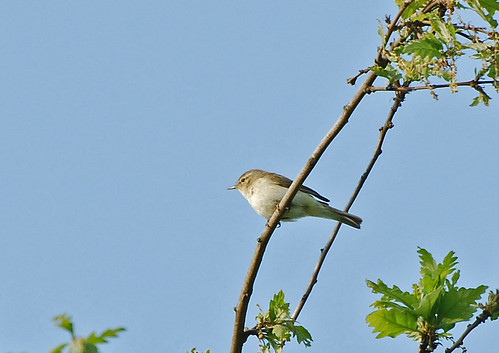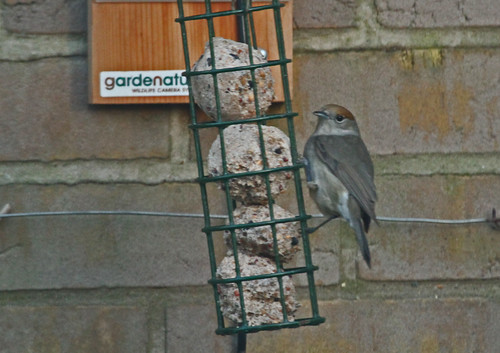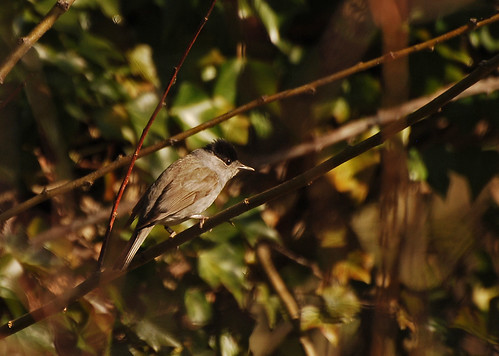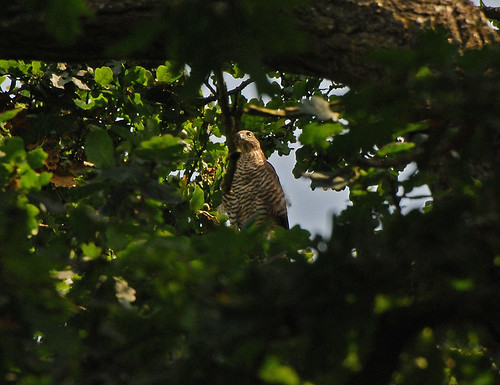Every month of the year has different conditions which create environmental niches that favour different flora, fauna and stages of life cycles. So as 2011 rushes headlong to its wintry conclusion, for my last post of the year I was going to select a single photograph to represent the month to month changes in our wildlife throughout the year. And that was of course impossible for a number of reasons, mainly because it was impossible to represent any one month with a single image, and also because I have lots of images that I like and I want to share. I eventually managed to whittle the number down to an average of two per month which include a wide range of our native creatures in the UK including birds (migrants and natives), butterflies, moths, flowers, amphibians and fungi. I hope you like them!
January
Every autumn lots of bird species vacate our shores to head to warmer parts of the world while we endure the cold of winter, and they’re replaced by other species which come from the north to the relative warmth of the UK in winter. Last year the autumn and winter weather in Scandinavia was ferocious and consequently many birds arrived here in larger numbers than usual, including the gorgeous waxwing. Along with the waxwing, redwing and fieldfare came too, as they do every year, and remained until the spring, providing some welcome colour.
 On a bright cold January day a lone fieldfare perched in a tree
On a bright cold January day a lone fieldfare perched in a tree
February
February was cold and the middle of the month saw us taking the children to the coast for our annual spring half term excursion, and this year we headed to the Suffolk coast at Dunwich. Dunwich is a really interesting place for lots of reasons, not least because the wildlife there is rich and varied. One of the harbingers of springtime which I look forward to every year is the flowering of snowdrops, and the woods on the edge of Dunwich were covered in them:

A carpet of snowdrops in the woods at Dunwich Greyfriars
March
By March many flowers were blooming and the fauna was turning it’s thoughts to matters procreational. And this dunnock was no exception:

A dunnock serenading the ladies from a bramble stem on Cambridge Science Park
Dunnocks have a rather to-the-point approach to the art of regeneration. They don’t get together in pairs as most birds do, they form small groups and mate with multiple partners and the males go as far as to remove packets of sperm from the cloaca of females who have been inseminated by rivals prior to passing on their own DNA. No nonsense!

A robin singing for a mate in an alder tree, also on Cambridge Science Park
And of course the birds aren’t the only creatures to get the urge in March. For the past 2-3 years a guided busway has been built between St Ives and Cambridge and as it approaches Cambridge Science Park it passes alongside a lake that is a spawning ground for thousands of toads which live in the adjacent woods and fields. The busway has therefore cut off the toads from the lake and, driven by the unstoppable instinct to reproduce, this pair were trying unsuccessfully to negotiate the sheer walls of the track. For a week in March I would get off my bike every morning on the way to work to help as many of them across as I could find.

The male toad is hitching a lift on the back of the much larger female on the way to the water to spawn
The male toad locks onto the back of the female with his front claws around her chest and he’s not at all keen to relinquish his grip until they’ve reached the water and he’s fertilised her eggs. After which armies of lone toads can be seen heading back the other way.
Fortunately for the toads Cambridge City Council funded the installation of toad tunnels under the busway so next year they should be able to negotitate the track and avoid the carnage which would otherwise have ensued. Hats off to the Council!
April
This month was a real wildlife fest and many types of creature allowed me to take some great photographs. The trees now have shooting leaves so everywhere has that lovely green colour from all the fresh growth.

Windswept male yellowhammer in the top of a hawthorn tree
The yellowhammer is a species which has become less and less common in recent decades as a result of hedgerow destruction and other modern farming methods, but we’re lucky to have plenty of hedgerows still in situ on the outskirts of Histon, and consequently, good numbers of these lovely yellow buntings. The hedgerow this one is on is mature and has old oak and ash trees in so it plays host to alot of bird species including blackcap, chiffchaff, dunnock, common whitethroat and green woodpecker, to name but a few.
Whilst sitting watching TV late one evening in March, what I initially thought was a bat emerged from behind the sofa I was sitting on with my wife. There had been no prior warning of its presence and myself and my wife both levitated off the sofa uttering something along the lines of “What the heck was that!?”. It fluttered into a lampshade where it staid long enough to get a photograph, and it turned out to be an emperor moth:

Our emperor moth inside a lamp. I though creatures like that only lived in tropical rainforests!
Unfortunately, a couple of days later I found her dead (she was the female of the species) still inside the lampshade. I extricated her and measured her and she was 7cm wingtip to wingtip. A magnificent beast.

A willow warbler beautifully framed by new leaves and blossom of the blackthorn tree
These little warblers which weigh on average around 9g have just arrived from southern Africa. I think bird migration is one of the most amazing natural phemonena – how does such a tiny creature navigate and survive a flight across the Sahara and then the Mediterranean? It’s absolutely incredible.

A pair of great crested newts getting ready to mate in a shallow pond – male on the left, more slender female to the right
The great crested newt was probably the highlight of my year. I’d never seen a newt before and in this pond there were great crested, palmate and smooth newts. I turned the flash power down and used an 18-55mm lens and got some reasonably good photographs of the newts underwater. And that at 1am after a few hours in the pub!
May
I’ve spent many a fruitless hour chasing orange spot butterflies up and down the hedgerows of Cambridgeshire, but they never seemed to settle for long enough to get a photograph. But one morning in May I must have timed it just right, they were in the mating mood.

Female orange spot announcing her availability in somewhat unambiguous fashion to a passing male who was just out of shot

Common whitethroat – these warblers also migrate to the UK from sub-Saharan Africa
The common whitethroat breeds in my local fields in good numbers. It’s easy to identify by its song and the way it perches on brambles and low scrub and then flits almost vertically up into the air to alight a few seconds later close to where it took off from and continue singing. This one is a male, he has a blue/grey head whereas the female has a brown head. As well as avian migrants from warmer climes, at this time of year many species of dragonfly are emerging:

Scarce chaser dragonfly at Milton Country Park
I like dragonflies. In the days of the dinosaurs there were dragonflies with a 75cm wingspan! They are fun to photograph (and often, not too difficult) they look awesome, and they have very interesting life cycles. My scarce chaser sat on a seed head for several minutes whilst I stood a few feet away photographing other dragons and damsels, occassionally he took off to circle the pond before returning to the same spot where he let me get to within around 50cm to capture his portrait.
June
In a normal year the weather will be warming up nicely by June and flowers and insects and birds should be in abundance. But 2011 wasn’t a normal year, April was unseasonally warm which kick started everything, but the rest of spring and summer were cold and this had dire consequences for many butterflies and other species. One of the few that I did see in reasonable numbers this year, although not as many as last year, was the large skipper.

Large skipper feasting on the nectar of a thistle
The marsh woundwort is so called because it has been applied to wounds to assist the healing process. I don’t know what the medical basis for that is, maybe it has antispetic properties. It has a beautiful flowerhead and is one a good number of wild flowers growing in the drainage dikes on the local farmland around Cambridge.
 Marsh woundwort poking it’s lovely head out of a drainage ditch which is full of various wild flowers every year
Marsh woundwort poking it’s lovely head out of a drainage ditch which is full of various wild flowers every year
July
I found this splendid looking cricket lurking in the grass in a field on the edge of Histon. I first thought it was a very green grasshopper until I looked more closely at the photograph, and it turned out to be a Roesels bush cricket. It is an introduced species from mainland Europe which until recently was only found in the most southerly parts of England. There are two varieties and this is the long winged one which can colonise further afield faster than its short winged cousin, and is now as far north as Cambridgeshire and beyond.

Long winged Roesels bush cricket
This was the first of its kind that I’d seen and a few days later another one appeared on a blind in my house, so I guess thay can’t be that uncommon in this region now.
 A pair of juvenile linnets
A pair of juvenile linnets
Before I got out walking in my local countryside around Histon I can’t remember the last time I saw a linnet, but they breed here in good numbers and in the winter flocks of many tens to hundreds can be seen on farmland around and about Histon. Linnet are finches which feed on seeds and the adult males are splendid with a cerise breast and a crimson spot on their foreheads.
August
When I was at school, many years ago, my Dad would feed the birds in the garden and it wasn’t particularly unusual to see the occasional bullfinch. But mainly as a result of persecution their numbers declined dramatically through the 1970’s and 80’s and I didn’t see one for years. The males are beautiful birds and I’ve been after a good photograph of one for a long time. And finally…

A male bullfinch crunching seeds at RSPB Fen Drayton
I love this picture – so far it’s the first and only half decent one I’ve managed. Hopefully I’ll get a few more to share with you in 2012.
Later in August, we were on holiday in Northumberland, and amongst the many gulls and other seabirds on the beach at Seahouses was this redshank. I think it’s nature at it’s aesthetic best!

A lone redshank looking for nourishment in the rockpools at Seahouses
September
 The biggest garden spider I’ve ever seen – she was around 4cm across
The biggest garden spider I’ve ever seen – she was around 4cm across
Another of natures harbingers, this time of autumn. My garden fills up with these polyocular purveyors of terror in September, and this lady was huge. She was 4cm across and was big enough to distract my son from a telling off. ‘Dad, there’s a big spider in my window‘ was an imaginative and very effective way to divert my attention from the misdemeanour of the moment. I ran to get my camera and I had to lay horizontally out of the bedroom window to take this photograph, as a result of which I couldn’t stay still for more than a few seconds!
October
After the coldest summer for 18 years we then had a mild autumn which meant that many creatures could be found out and about long after they have normally migrated or hibernated, or died off. Swallows and swifts were still being seen into October and a bumblebee flew past my lab window one day last week. During a visit to Milton Country Park, on the northern edge of Cambridge, on 28th October, to see what winter wildfowl had arrived, there were some winter visitors including tufted duck, gadwall and widgeon. But the pontoon I was stood on had around half a dozen common darter dragonflies on it along with several species of damselfly in the surrounding reedbed and a lone migrant hawker patrolling the air which took a common darter and butchered it on the wing right over my head. Dragonflies can be seen late in the year when the weather permits, but even so I was surprised to see so many at the end of October.
 A pair of common darters mating in the late autumn sunshine
A pair of common darters mating in the late autumn sunshine
November
One of my November excursions took me to RSPB Fowlmere, between Cambridge and Royston, which is renowned for its water rails. I don’t think I’d ever seen one before but I was tipped off by a fellow naturalist that there was one in front of a particular hide, so I headed off there and there it was, busy foraging in the pond for the whole hour I sat there. It was very murky so the photographic conditions were difficult, but I managed to get a couple of decent pictures and I particularly like this one:
 A water rail in the primeval swamps of Cambridgeshire!
A water rail in the primeval swamps of Cambridgeshire!
And another of my trips in November was to Norsey Wood in Essex which is a very different ecosystem to Fowlmere, consisting of ancient oak, beech and birch wood. So in autumn the forest floor is a really good location for fungi and this fly agaric was one of a large group growing out of the leaf litter.

Fly agaric mushroom amongst the fallen beech leaves of Norsey Wood
December
And finally, a wildlife success story is the long tailed tit. Until the last 10-15 years I only saw these occasionally but they now seem to be common, in direct contrast to so many other species of bird whose numbers are declining. I regularly see flocks of long tailed tits on the feeders in my garden and in the hedgerows and woods around Histon. They’re gorgeous little birds and I love watching a flock of them follow each other one after the other along a hedgerow before bunching together when they have found a food source and then heading off again in line astern.
 A long tailed tit in the hedges along Guns Lane in Histon
A long tailed tit in the hedges along Guns Lane in Histon
I stood quietly for several minutes watching the flock of around 15 birds that this one belonged to and they didn’t seem at all bothered by me as they picked insects from the trees.
So there you have it. 2011 in pictures. If you had the stamina to get this far, thankyou and I hope you enjoyed it.
Best wishes for a very happy Christmas and a peaceful and successful New Year from The Naturephile!
 Chiffchaff male declaring his availability in early spring
Chiffchaff male declaring his availability in early spring Willow warbler parent with a beak full of insects heading for the nest
Willow warbler parent with a beak full of insects heading for the nest Another foray to collect flies for the chicks
Another foray to collect flies for the chicks Pausing to check up on me before heading into the nest
Pausing to check up on me before heading into the nest  Whitethroat male – my best ever bird portrait!
Whitethroat male – my best ever bird portrait! A male songthrush (Turdus philomelos, Dansk: sangdrossel) filling the meadow with song
A male songthrush (Turdus philomelos, Dansk: sangdrossel) filling the meadow with song










































































